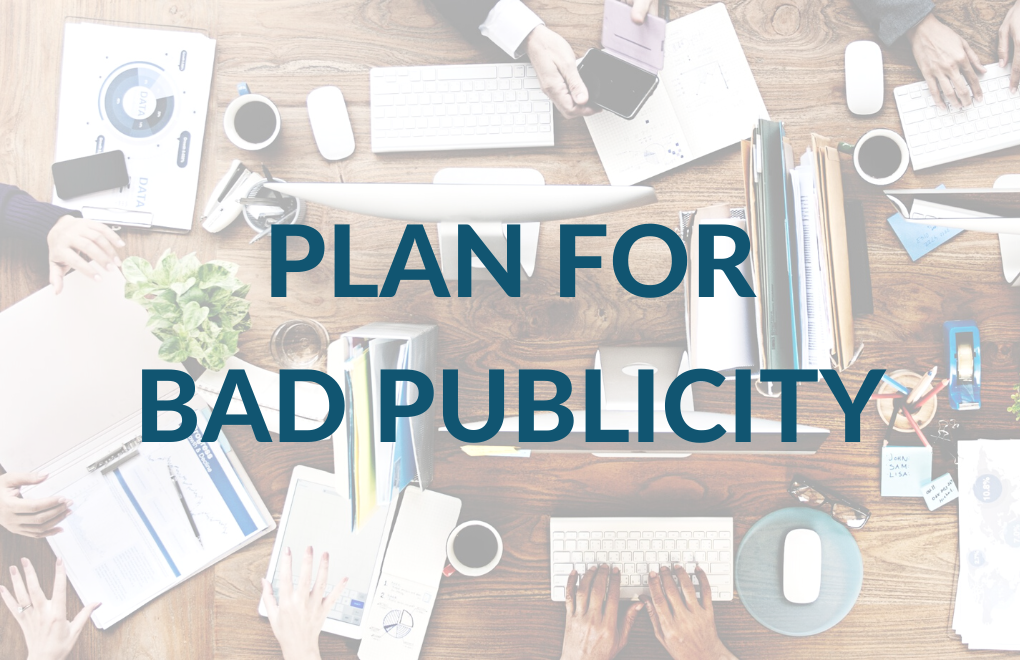When your brand grows, the risk of bad publicity increases. Prepare for that day to sail through the storm with ease and without fear.
Parenting is a good school for crisis communication and reputation management.
I shared the story of my daughter and the wine glasses in my newsletter last week, but here’s a quick recap. (Sign up to receive real life stories of how small businesses have learned to use content to grow their businesses!)
- I walked into our kitchen and found my 6-year old holding wine glasses in a less-than-secure way.
- My first instinct was to tell her to put them down immediately and to be more careful.
- Somehow I managed to hold myself back and take a breath.
- Finally, we talked about what to do should the glasses break, and the discussion shifted to managing the consequences.
What If My Business Gets Bad Publicity?
This incident – while not exactly a communications crisis – led me to think about how many entrepreneurs and businesses approach their social media and visibility.
Especially at the moment when they start expanding their reach and getting more visibility, the worries rise.
What if my well-meaning post is misunderstood?
What if a displeased client complains about us publicly?
What if we make a mistake?
Basically: What if my best wine glasses fall down and get broken?
The unpleasant truth is, that with a wider network and business growth, the risk of bad publicity, misunderstanding and complaints increase, too.
Still, the reflex shouldn’t be “What can I do to keep bad things from happening?”
A much better question is “What will I do, if one day I find myself in shatters?”
7 Steps to Clean Up a Communications Mess
In each crisis, there are three stages:
- The storm, which often takes us by surprise and can feel uncontrollable.
- The managing phase, where we work to limit the damage and regain our followers’, clients’ or network’s trust.
- The exit, where the discussion will switch gears.
By preparing for all three stages, you’ll have more control over the discussion and you can also make the storm pass more quickly. If planned and managed skillfully, what seemed like a crisis can even become a way to gain a visibility boost.
Even if you’re working alone or have a few freelancers supporting you, having clarity on when to take action and what to do will give you reassurance that you’ll be able to manage no matter what happens.
Come annoyed LinkedIn followers or displeased clients, you and your team know what to do and when.
Here are seven questions your crisis communication plan should answer.
1 – Which are the most likely crises for your business?
List the most common threats you can imagine from a product or service failure to a client complaint to a PR hurricane because of a badly placed social media post. In the first stage, it is often easier to create a detailed plan for 1-3 most likely scenarios and adjust it to other scenarios.
2 – What will your key message be in each crisis?
If the worst-case scenarios come true, what will be your most important message to get out? How will you respond to unjustified criticism or valid complaints? Stick to 1-3 points for clarity and memorability.
3 – When will you take action?
Set a timeline for each of your scenarios. Which of them need an immediate response, day or night, Sunday or Wednesday? Which can wait half-a-day or a full day? The rule of thumb is: the earlier the better, and even if you choose to wait, keep monitoring the situation, as it can change rapidly.
4 – What exactly will you do?
Time to get really specific! What shall you and / or your team do when the time to act comes? Will you release a statement, comment on social media, block comments or delete a post? When a crisis hits, you’ll be under stress and you’ll need to act quickly, so having detailed guidelines takes decision-making out of the equation.
5 – Which materials do you need to support your message?
Responding to challenging situations is quicker and easier when you’ve thought about your message in advance. Prepare a list of support materials, such as Q&A’s, message and response templates and talking points.
6 – Who can you ask for help?
Sometimes managing alone is no longer an option. Write a list of people who can help you if needed, be it a social media assistant to manage comments, a PR professional to untangle the mess or a fellow entrepreneur who provides emotional support.
7 – How do you recuperate after the storm has passed?
When the worst passes, what will you do to control the discussion and highlight the uniqueness of your brand? By planning ahead and managing the conversation actively, you can get a chance to highlight why your brand is unique and different. Maybe what seemed like the worst-case scenario is the first step up to the next level?
Your Business Needs a Crisis Communication Plan Today
The thing about crises is that we never know when they will hit us. In the best case scenario, you’ll never need this plan.
But you need to create it.
Crisis communication planning is like wearing a seatbelt in a car. You hope it will never have to save your life, but if that happens, you’ll be happy you wore one. You don’t want to take your chances and trust in good fortune “just this once”, do you?
Take this chance to prepare for the unexpected and use it to build a stronger, more powerful brand.
If creating a plan still feels overwhelming, scary or something you’d like to postpone forever, why don’t you schedule a complementary Content Strategy Call? I’ll help you set up a plan that propels your brand to success without worry and fear.







Recent Comments